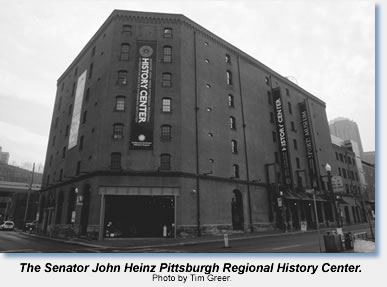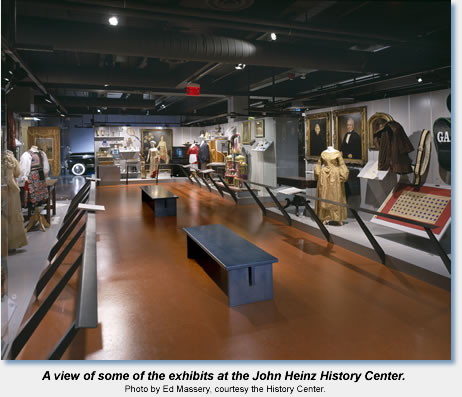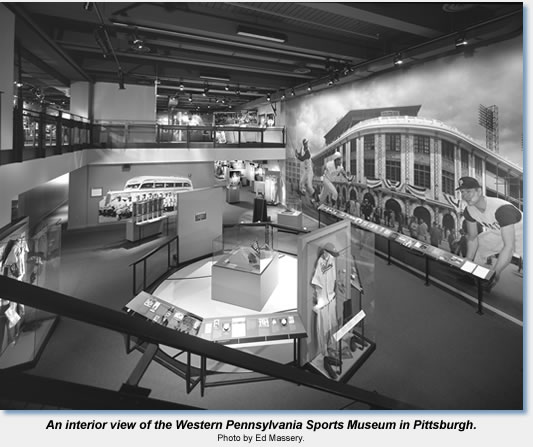News
Heinz History Center Expands, Opens Pennsylvania Sports Museum
 The Senator John Heinz Pittsburgh Regional History Center, located in Pittsburgh, Pennsylvania, celebrated the opening of a five-story expansion to its facilities in November 2004. The new wing brings the size of the History Center to 210,000 square feet of museum and research space, and allows the History Center to expand the resources available to historians of the western Pennsylvania region. The two keynote features of the History Center's new wing are the Ann and Martin G. McGuinn Gallery and the Western Pennsylvania Sports Museum.
The Senator John Heinz Pittsburgh Regional History Center, located in Pittsburgh, Pennsylvania, celebrated the opening of a five-story expansion to its facilities in November 2004. The new wing brings the size of the History Center to 210,000 square feet of museum and research space, and allows the History Center to expand the resources available to historians of the western Pennsylvania region. The two keynote features of the History Center's new wing are the Ann and Martin G. McGuinn Gallery and the Western Pennsylvania Sports Museum.
The center's CEO, Andy Masich, told Perspectives in a telephone conversation that the groundwork for the History Center's expansion was laid in 1998. Community leaders, the museum's board of directors, and staff collaborated on a strategic plan to further expand what was already one of the largest history museums in Pennsylvania. The strategic plan had two goals: first, to broaden the History Center's audience, and second, to expand the museum's coverage of sports and recreation, a component that many felt was missing.
For the general public, the most enticing part of the expanded History Center is undoubtedly the new Western Pennsylvania Sports Museum, which permanently occupies two floors of the new wing. Masich called this 20,000-square-foot space a "museum within a museum," as it is branded separately and has its own directors and advisers. A large section of the museum is dedicated to Pittsburgh's three professional sports franchises—the NHL's Penguins, the National League's Pirates, and the NFL's Steelers—who provided significant support for establishing the museum. Former players, sportswriters, and local sports legends formed an 80-member "Champions Committee," which, Masich said, was instrumental in fundraising, promotion, and in acquiring artifacts. The sports museum's displays tell team histories through descriptions, photographs, artifacts (old uniforms, shoes, equipment, and trophies), and video and audio clips of great moments in team history. Visitors can sit down and listen to original broadcasts of Pirates games, for example, or watch film clips from old Steelers games. There are also several interactive stations designed for the family. The Steelers seem to have received more exhibit space than the other two professional franchises, probably due to the region's special affection for football. Penn State, the University of Pittsburgh, and regional high school football teams—all have significant displays. The museum also shows how the game of football has evolved in western Pennsylvania over the past century, from a school and club sport to a professional enterprise. The sport of golf has a strong presence in the museum as well, because western Pennsylvania is home to both Arnold Palmer and the Oakmont County Club (frequent site of the U.S. Open). Horse and automobile racing are also well represented.
The Western Pennsylvania Sports Museum is not just a shrine to local big-time sports, however. The people of Pittsburgh maintain strong ethnic identities, and the museum shows how various immigrant groups contributed to sports in the city in the early 20th century. The city's ethnic immigrants brought their favorite sports over from their home countries and they played them in their neighborhoods. There is a display, for example, on Italian immigrants who played bocce incessantly, set up bocce courts in their backyards, and competed against friends and neighbors. Another display highlights the sport of Gaelic football brought over by Irish immigrants. Other displays look at the connections between sports and the industrial workplace via company baseball or football teams, or sports and the community. The region's athletic associations, which were once organized around neighborhood or ethnic lines, are also given a solid overview.  These athletic associations, established to promote physical and moral fitness in both young men and women, produced many of the region's amateur sports heroes and Olympic representatives throughout the 20th century. One such local hero was Steelers founder Arthur J. Rooney, who made a name for himself in the 1920s in the Pittsburgh Athletic Association as a baseball player and as an Olympic-caliber boxer before turning to football ownership. The city's African Americans are also represented in the neighborhood sports and athletic association sections, as well as in a special section on Negro League baseball. The city's representatives—the Homestead Grays and the Pittsburgh Crawfords—were two of the league's most storied franchises. Artifacts from both teams are on display, and the museum runs a film featuring interviews with surviving players and staff.
These athletic associations, established to promote physical and moral fitness in both young men and women, produced many of the region's amateur sports heroes and Olympic representatives throughout the 20th century. One such local hero was Steelers founder Arthur J. Rooney, who made a name for himself in the 1920s in the Pittsburgh Athletic Association as a baseball player and as an Olympic-caliber boxer before turning to football ownership. The city's African Americans are also represented in the neighborhood sports and athletic association sections, as well as in a special section on Negro League baseball. The city's representatives—the Homestead Grays and the Pittsburgh Crawfords—were two of the league's most storied franchises. Artifacts from both teams are on display, and the museum runs a film featuring interviews with surviving players and staff.
The History Center became a Smithsonian Institution affiliate in 2000. Masich explained that this contractual arrangement with the Smithsonian, which recognizes that the History Center maintains a high standard of excellence, allows the History Center to share programs and staff with the Smithsonian, as well as requires the History Center to keep Smithsonian artifacts on exhibit at all times. The new Ann and Martin G. McGuinn Gallery on the first floor gives the History Center a spacious area to display traveling Smithsonian Institution exhibits. The first exhibit in the McGuinn Gallery was the Smithsonian's September 11: Bearing Witness to History, which was at the History Center from September 11, 2004, to January 2, 2005. This emotionally gripping exhibit included more than 40 artifacts from the World Trade Center, the Pentagon, and Shanksville, Pennsylvania; an ABC News video retrospective; audio and written remembrances of 9/11; and a History Center special addition to the exhibit on Pennsylvanians who helped with recovery efforts. On February 23, 2005, the Smithsonian traveling exhibit Breaking Records, Breaking Barriers, a sports history exhibit, opened. It will be followed on May 1, 2005, by Clash of Empires: The British, French, and Indian War, 1754–63, which is being developed by the History Center in collaboration with the Canadian War Museum and the Smithsonian Institution. This exhibit, which will be at the History Center for a year, will have more than 200 artifacts, some of which have not been seen in the United States since the war's conclusion.
Also part of the History Center's expansion are a new Special Collections Gallery and a theater and education center. The Special Collections Gallery allows visitors to see items in "visible storage." The items in the gallery are arranged by ethnic group rather than by artifact type, Masich explained, because in their long-range planning the History Center's directors found that many Pittsburghers still identify themselves by their ethnic origins (85 percent of the History Center's patrons are from western Pennsylvania). Audio narration guides visitors through the collections. The theater features educational movie and theatrical productions. In November and December 2004, the theater showed a musical based on the early years of George Washington.
According to communications manager Ned Schano, the History Center's expansion has more than lived up to expectations. Attendance for November and December 2004 was more than double the attendance for the same months in 2003. More than 15,000 people visited the History Center in December 2004 alone. Masich added that the museum has also seen a demographic shift in attendance. More than before, young couples and families with young children are coming to the History Center, and not just for the sports museum but for the other exhibits as well—and thus creating what Masich jokingly referred to as a "Cheerios [on the floor] problem," a problem that he thought was wonderful for any museum to have. By any measure, the History Center has succeeded in meeting its goal to broaden its audience.
 The Senator John Heinz Pittsburgh Regional History Center opened its doors in 1996. The original building was former home of the Chautauqua Lake Ice Company, whose industrial character it retains with its red brick exterior and brick and exposed metal interior. The original section of the History Center features a library and archives documenting 250 years of western Pennsylvania's history, with the strength being the 19th century. The archives have over 500,000 photographs, as well as the papers from the giants of Pittsburgh's industrial past like U.S. Steel, Westinghouse, Alcoa, and the H. J. Heinz Company. The library and archives professional staff offers assistance for genealogical and historical research, while the History Center itself offers guided tours for students, tailored to meet their teacher's needs. The History Center's collections include an Italian American collection provided by the Historical Society of Western Pennsylvania and an African American collection. The History Center also has several public exhibits, including its core regional history exhibit Points In Time: Building a Life in Western Pennsylvania, 1750–Today, which traces the region's history from its birth as a colonial outpost and gateway to the West, through its development as the center of the steel industry, a target for waves of European immigration, a hotbed of labor unrest, a member of the Rust Belt, and ultimately to its current efforts to re-invigorate and redefine itself for the 21st century. Other permanent exhibits are Glass: Shattering Notions, an artifact collection from Pittsburgh's glass industry, and Heinz 57, a history of the food industry giant H. J. Heinz Company, which got its start in a local home kitchen. Recent temporary exhibits have included a bicentennial look at the Lewis and Clark expedition, Rediscovering Lewis & Clark.
The Senator John Heinz Pittsburgh Regional History Center opened its doors in 1996. The original building was former home of the Chautauqua Lake Ice Company, whose industrial character it retains with its red brick exterior and brick and exposed metal interior. The original section of the History Center features a library and archives documenting 250 years of western Pennsylvania's history, with the strength being the 19th century. The archives have over 500,000 photographs, as well as the papers from the giants of Pittsburgh's industrial past like U.S. Steel, Westinghouse, Alcoa, and the H. J. Heinz Company. The library and archives professional staff offers assistance for genealogical and historical research, while the History Center itself offers guided tours for students, tailored to meet their teacher's needs. The History Center's collections include an Italian American collection provided by the Historical Society of Western Pennsylvania and an African American collection. The History Center also has several public exhibits, including its core regional history exhibit Points In Time: Building a Life in Western Pennsylvania, 1750–Today, which traces the region's history from its birth as a colonial outpost and gateway to the West, through its development as the center of the steel industry, a target for waves of European immigration, a hotbed of labor unrest, a member of the Rust Belt, and ultimately to its current efforts to re-invigorate and redefine itself for the 21st century. Other permanent exhibits are Glass: Shattering Notions, an artifact collection from Pittsburgh's glass industry, and Heinz 57, a history of the food industry giant H. J. Heinz Company, which got its start in a local home kitchen. Recent temporary exhibits have included a bicentennial look at the Lewis and Clark expedition, Rediscovering Lewis & Clark.
The Senator John Heinz Pittsburgh Regional History Center is open daily 10 a.m. to 5 p.m. and is located at 1212 Smallman Street in Pittsburgh's Strip District. The History Center's web site is www.pghhistory.org. Admission to both the History Center and the Western Pennsylvania Sports Museum is $7.50 for adults, $6 for seniors, $5 for college students (with valid identification), $3.50 for children 6–18, and free for children 6 and under. Parking is free and abundant, except during Steelers home games (naturally!).
— David Darlington is associate editor of Perspectives. He visited (and enjoyed) the Senator John Heinz Pittsburgh Regional History Center and the Western Pennsylvania Sports Museum on a recent trip to Pittsburgh.
Tags:
Comment
Please read our commenting and letters policy before submitting.






